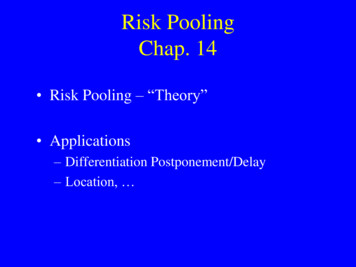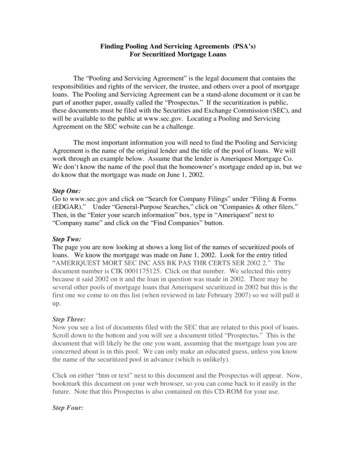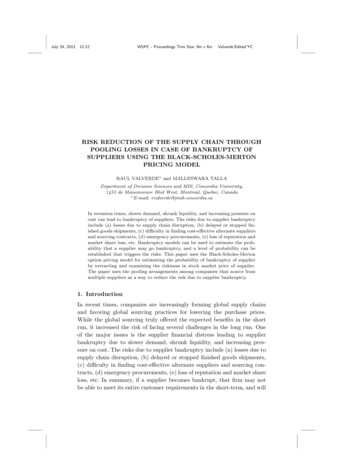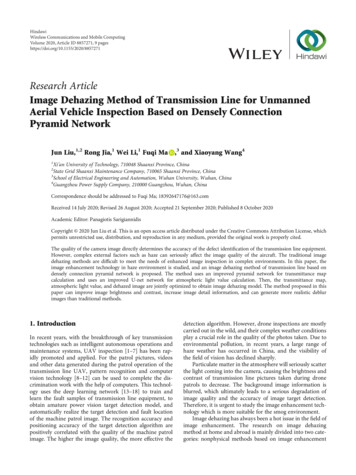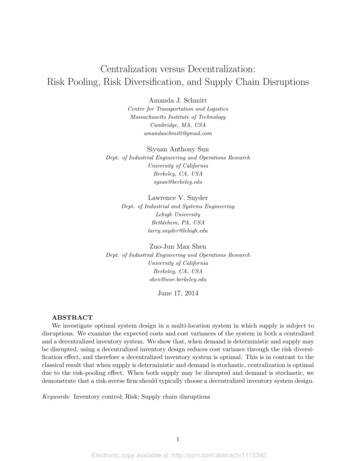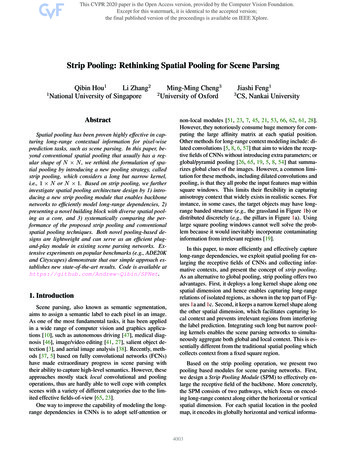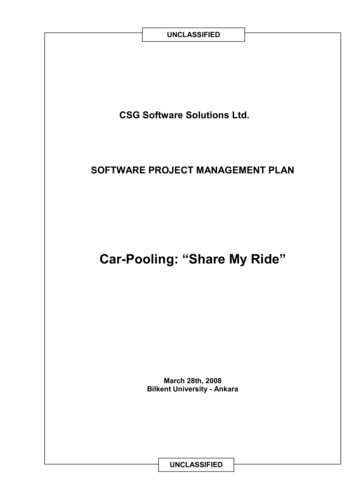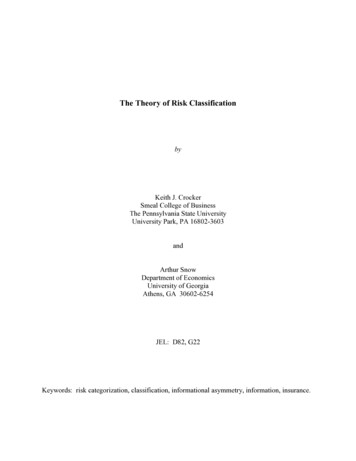
Transcription
Methods of Risk Pooling in Business Logisticsand Their ApplicationInauguraldissertationzur Erlangung des akademischen Grades„Doktor der Wirtschaftswissenschaften“(Dr. rer. pol.)eingereicht an derWirtschaftswissenschaftlichen Fakultätder Europa-Universität Viadrinain Frankfurt (Oder)im September 2010vonGerald OeserFrankfurt (Oder)
“Uncertainty is the only certainty there is,and knowing how to live with insecurity is the only security.”John Allen Paulos,Professor of Mathematics at Temple University in Philadelphia
To my brother,who never failed to support me
AcknowledgementsFirst and foremost I would like to express my gratitude to my Ph.D. advisor Prof. Dr.Dr. h.c. Knut Richter, Chair of General Business Administration, especially IndustrialManagement, European University Viadrina Frankfurt (Oder), Germany for his extensivementoring. He also kindly gave me the opportunity of gaining experience in teaching graduate courses in addition to my research.For willingly delivering his expert opinion on my thesis as the second referee I thankProf. Dr. Joachim Käschel, Professorship of Production and Industrial Management, Technical University Chemnitz, Germany very much.I would also like to gratefully acknowledge the support of all employees of Prof. Richter's chair, especially Dr. Grigory Pishchulov: Among other things, he helped me carry outthe “Subadditivity Proof for the Order Quantity Function (5.1)” in Appendix E mathematically formally correctly.Furthermore, I thank Prof. Dr. Dr. h.c. Werner Delfmann, Director of the Department ofBusiness Policy and Logistics, University of Cologne, Germany for the opportunity offeredand for showing me that the world cannot be explained by mathematics alone.Moreover, I appreciate the diverse support of the following professors during my Master's and doctoral studies: Ravi M. Anupindi (University of Michigan), Ronald H. Ballou(Case Western Reserve University), Gérard Cachon (University of Pennsylvania), IanCaddy (University of Western Sydney, Australia), Sunil Chopra (Northwestern University), Chandrasekhar Das (emeritus, University of Northern Iowa), David Dilts (OregonHealth and Science University), Bruno Durand (University of Nantes, France), Philip T.Evers (University of Maryland), Amit Eynan (University of Richmond), Dieter Feige(emeritus, University of Nuremberg, Germany), Jaime Alonso Gomez (EGADE - Tec deMonterrey, Mexico City and University of San Diego), Drummond Kahn (University ofOregon), Peter Köchel (emeritus, Technical University Chemnitz, Germany), David H.Maister (formerly Harvard Business School), Alan C. McKinnon (Heriot-Watt University,UK), Esmail Mohebbi (University of West Florida), Steven Nahmias (Santa Clara University), Teofilo Ozuna, Jr. (The University of Texas-Pan American), David F. Pyke (University of San Diego), Pietro Romano (University of Udine, Italy), Wolfgang Schmid (European University Viadrina Frankfurt (Oder), Germany), Yossi Sheffi (Massachusetts Institute of Technology), Edward Silver (emeritus, University of Calgary, Canada), Jacky YukChow So (University of Macau, China), Jayashankar M. Swaminathan (University of
North Carolina), Christian Terwiesch (University of Pennsylvania), Ulrich Thonemann(University of Cologne, Germany), Biao Yang (University of York, UK), and Walter Zinn(The Ohio State University).I express gratitude to the paper merchant wholesaler Papierco for the insight into its operations, the opportunity of optimizing its logistics, and the financial support.I am also thankful to my friends: Without them writing this dissertation would havebeen a lonesome experience.Finally, I thank my father for constantly pushing and financially supporting me andproofreading my thesis.
GeleitwortDie vorgelegte Dissertation widmet sich dem großen Thema Risk Pooling in der BusinessLogistik. Die Aggregation von Risiken der Logistikprozesse ist ein derart universellesProblem, so dass Autoren verschiedenster Wissenschafts- und Anwendungsgebiete dazuihre Positionen, Lösungsansätze und Modelle dargestellt haben. Bisher hatte noch niemandden Mut aufgebracht, diese kaum überblickbare Menge an Literaturquellen zu sichten undnach wissenschaftlichen Kriterien zu ordnen. Herr Oeser hat sich dieser Aufgabe gestelltund hat sie mit Bravour gemeistert.Bei aller Bedeutung dieser aufwendigen akademischen Aktivitäten darf jedoch nicht vergessen werden, dass Risk Pooling ein Problem der Praxis ist, und dass die entsprechendentheoretischen Untersuchungen letztendlich der Praxis dienen sollen. Die Vielfältigkeit desProblems kann dabei kaum durch ein relevantes Basismodell erfasst werden. Es ist dasVerdienst des Autors, mit der Entwicklung einer Grundkonzeption für ein Entscheidungsunterstützungssystem zur Auswahl der geeigneten Risk Pooling Strategien Unternehmenund besonders Unternehmensberatungen ein Instrument in die Hand zu geben, mit demsich die vielfältigen Situationen der Unternehmen analysieren lassen. Er belässt es jedochnicht beim Entwurf der Konzeption, sondern demonstriert auch überzeugend dessen Anwendung anhand eines Unternehmens.Es ließen sich viele weitere Vorzüge des hier veröffentlichten Werkes nennen. Es soll andieser Stelle jedoch dem Leser überlassen bleiben sich ein Urteil zu bilden. Herr Oeserbietet dem Leser mit seiner Dissertation auf jeden Fall keine „leichte Kost“, denn der behandelte Gegenstand lässt eine oberflächliche Betrachtung nicht zu.Wer sollte dieses Werk lesen? Wissenschaftler und Studenten aus den Gebieten OperationsManagement, Logistik, Operations Research werden hier viel Neues und Interessantes,auch viele Probleme für die weitere Forschung finden. Unternehmensberatungen werdenviele angeführte Lösungen zur Komplexitätsbewältigung in ihren Projekten anwendenkönnen. Ich bin überzeugt, dass die vorgelegte Dissertation neue Forschungen und Projekteanregen wird. Das ist das Schönste, was sich ein Autor wohl wünschen kann.Prof. Dr. Dr. h.c. Knut Richter
Table of ContentsList of Figures . XList of Tables . XIList of Abbreviations, Signs, and Symbols . XIIAbstract. XIV1Introduction . 11.1Problem: Growing Uncertainty in Business Logistics andNeed for a Tool to Choose Among Risk Pooling Countermeasures . 11.2Objective . 31.3Object and Method . 31.4Structure and Contents . 42Risk Pooling in Business Logistics . 62.1Business Logistics Risk Pooling Research . 62.2Placing Risk Pooling in the Supply Chain, Business Logistics,and a Value Chain . 82.3Defining Risk Pooling . 112.4Explaining Risk Pooling . 142.5Characteristics of Risk Pooling . 193Methods of Risk Pooling . 243.1Storage: Inventory Pooling . 273.2Transportation . 353.2.1Virtual Pooling . 353.2.2Transshipments . 353.3Procurement . 403.3.1Centralized Ordering . 403.3.2Order Splitting . 413.4Production . 433.4.1Component Commonality . 433.4.2Postponement . 453.4.3Capacity Pooling . 49VII
Table of Contents3.5Sales and Distribution . 513.5.1Product Pooling . 513.5.2Product Substitution . 524Choosing Suitable Risk Pooling Methods . 534.1Contingency Theory . 534.2Conditions Favoring the Individual Risk Pooling Methods . 544.3The Risk Pooling Methods' Advantages, Disadvantages,Performance, and Trade-Offs . 554.4A Risk Pooling Decision Support Tool . 565Applying Risk Pooling at Papierco . 745.1Papierco . 745.2Problems Papierco Faces . 755.2.1Fierce Competition in German Paper Wholesale . 755.2.2Supplier Lead Time Uncertainty . 755.2.3Customer Demand Uncertainty . 765.2.4Distribution Requirements Planning (DRP) . 805.2.5Demand Forecasting Methods . 825.3Solving Papierco's Problems . 875.3.1Determining Suitable Risk Pooling Methods for Papierco . 875.3.2Emergency Transshipments between Papierco's German Locations . 915.3.2.1Optimizing Catchment Areas . 915.3.2.2Increase in Transshipments and Its Causes . 945.3.2.3Transshipments Are Worthwhile for Papierco . 965.3.3Centralized Ordering . 1015.3.3.1Papierco's Current Order Policy . 1015.3.3.2Stock-to-Demand Order Policy with Centralized Ordering andMinimum Order and Saltus Quantities . 1055.3.3.3Benefits of Centralized Ordering for Papierco . 1075.3.4Product Pooling . 1175.3.5Inventory Pooling . 1185.3.6Challenges in IT and Organization . 1215.4Summary . 1236Conclusion . 126VIII
Table of ContentsAppendix A: A Survey on Risk Pooling Knowledge and Application in102 German Manufacturing and Trading Companies . 1341Introduction . 1351.1Motivation: Scarce Survey Research on Risk Pooling . 1351.2Objective . 1402The Survey . 1422.1Research Design . 1422.2Data Analysis and Findings . 1472.2.1Risk Pooling Knowledge and Utilization inthe German Sample Companies . 1472.2.2Association between the Knowledge ofDifferent Risk Pooling Concepts . 1512.2.3Association between Knowledge and Utilization ofRisk Pooling Concepts . 1542.2.4Association of the Utilization of Different Risk Pooling Concepts . 1562.2.5Risk Pooling Knowledge and Utilization inthe Responding Manufacturing and Trading Companies . 1612.2.6Knowledge and Utilization of the Different Risk Pooling Conceptsin Small and Large Responding Companies . 1643Critical Appraisal . 1664Questionnaire . 1695Answers . 170Appendix B: Proof of the Square Root Law for Regular, Safety, andTotal Stock . 172Appendix C: What Causes the Savings in Regular Stock through CentralizationMeasured by the SRL? . 176Appendix D: Tables . 178Appendix E: Subadditivity Proof for the Order Quantity Function (5.1) . 202Bibliography . 204IX
List of FiguresFigure 2.1:Number of Publications on Risk Pooling in Business Logistics . 7Figure 2.2:Placing Risk Pooling in Business Logistics . 9Figure 2.3:Important Value Activities Using Risk Pooling Methods . 11Figure 4.1:Risk Pooling Decision Support Tool . 56Figure 5.1:Total Fine Paper Sales in Tons per Month in Germany(BVdDP 2010a: 8) . 76Figure 5.2:Papierco's Total Fine Paper Sales to Customers in Germanyin Tons per Month . 77Figure 5.3:Papierco's 2007 Warehouse Sales to Customers per Weekof Seven Standard Paper Products from the Hemmingen Warehouse . 78Figure 5.4:2007 Incoming Goods, Warehouse Sales, and Inventory atWarehouse Hemmingen . 80Figure 5.5:2007 Incoming Goods, Warehouse Sales, and Inventory atWarehouse Reinbek . 81Figure 5.6:Comparison of Current and Optimal Catchment Areas of Papierco'sWarehouses . 93Figure 5.7:Inventory Turnover Curves for Papierco . 104Figure 5.8a:Product Purchase Planning at Papierco's Member Companies . 120Figure 5.8b:Product Purchase Planning at Papierco's Member Companies . 120Figure 5.9:Stockkeeping at Papierco's Warehouses in February 2008 . 121Figure A.1:Risk Pooling Knowledge and Utilization inthe German Sample Companies . 147Figure A.2:Risk Pooling Knowledge and Utilization in theSample Manufacturing and Trading Companies . 161Figure A.3:Knowledge and Utilization of the Different Risk Pooling Concepts inSmall and Large Responding Companies . 164Figure A.4:Questionnaire . 169X
List of TablesTable 3.1:Risk Pooling Methods' Building Blocks . 26Table 5.1:The Extent of Transshipments at Papierco . 94Table 5.2:Effects of Centralized Ordering at Papierco . 109Table A.1:Comparing Respondents with the Total Population ofManufacturing and Trading Companies in Germany . 143Table A.2:Significant Correlations at the 5 % Level ofthe Knowledge of Risk Pooling Concepts . 154Table A.3:Significant Correlations at the 5 % Level (except in the case ProductSubstitution/Demand Reshape) between Knowledge andUtilization of Risk Pooling Concepts . 155Table A.4:Significant Correlations at the 5 % Level between the Utilization ofRisk Pooling Concepts . 160Table A.5:Survey Participants' Answers to the Questionnaire . 171Table D.1:Fulfillment of the SRL's Assumptions by Eleven Surveyed Companies . 178Table D.2:Comparison of Important Inventory Consolidation Effect,Portfolio Effect, and Square Root Law Models . 179Table D.3:Conditions Favoring the Various Risk Pooling Methods . 185Table D.4The Risk Pooling Methods' Advantages, Disadvantages,Performance, and Trade-Offs . 195XI
List of Abbreviations, Signs, and SymbolsCommon general, business, logistics, supply chain management (SCM), operations research (OR), mathematical, and statistical abbreviations, signs, and symbols apply1 and arenot listed here.CCcomponent commonalityCEconsolidation effectCOcentralized orderingCOEcentralized ordering effectCOVcoefficient of variation of demandCPcapacity poolingCScycle stockDipl.-Kfm.Diplomkaufmann (MBA equivalent)DPdemand poolingDURdemand uncertainty reductionEFReffective fill rate for the customerELTemergency lateral transshipmentEOSeconomies of scaleFRitem fill rateICinventory holding costi. i. d.independent and identically distributedIPinventory poolingITOin terms ofLPlead time poolingLTlead timeLTURlead time or lead time uncertainty reductionn. e. c.not elsewhere classifiedNLTendogenous lead timesOPorder policyOSorder splitting1Cf. e. g. Soanes and Hawker (2008), Friedman (2007), Lowe (2002), Obal (2006), Silver et al. (1998) andSlack (1999), Clapham and Nicholson (2009), and Dodge (2006).XII
List of Abbreviations, Signs, and SymbolsPCEportfolio cost effectPEportfolio effectPMpostponementPoDpoint of (product) differentiationPPproduct poolingPQEportfolio quantity effectPREproportional reduction of errorPSproduct substitutionRMSEroot mean square errorRPDSTrisk pooling decision support toolRSregular stockSLtransshipment sending locationSLAservice level adjustmentsqrtsquare rootSRLsquare root lawSSsafety stockTCtransportation costTStransshipmentsTSCtransshipment costVPvirtual poolingvs.versus, here: is traded off againstXLTexogenous lead times is approximately equal to is preferred toXIII
AbstractPurpose/topicality: Demand and lead time uncertainty in business logistics increase, but canbe mitigated by risk pooling. Risk pooling can reduce costs for a given service level, which isespecially valuable in the current economic downturn. The extensive, but fragmented and inconsistent risk pooling literature has grown particularly in the last years. It mostly deals withspecific mathematical models and does not compare the various risk pooling methods in termsof their suitability for specific conditions.Approach: Therefore this treatise provides an integrated review of research on riskpooling, notably on inventory pooling and the square root law, according to a value-chainstructure. It identifies ten major risk pooling methods and develops tools to compare andchoose between them for different economic conditions following a contingency approach.These tools are applied to a German paper merchant wholesaler, which suffers from customer demand and supplier lead time uncertainty. Finally, a survey explores the knowledgeand usage of the various risk pooling concepts and their associations in 102 German manufacturing and trading companies. Triangulation (combining literature, example, modeling,and survey research) enhances our investigation.Originality/value: For the first time this research presents (1) a comprehensive andconcise definition of risk pooling distinguishing between variability, uncertainty, and risk,(2) a classification, characterization, and juxtaposition of risk pooling methods in businesslogistics on the basis of value activities and their uncertainty reduction abilities, (3) a decision support tool to choose between risk pooling methods based on a contingency approach, (4) an application of risk pooling methods at a German paper wholesaler, and (5) asurvey on the knowledge and utilization of risk pooling concepts and their associations in102 German manufacturing and trading companies.XIV
1Introduction1.1Problem: Growing Uncertainty in Business Logistics andNeed for a Tool to Choose Among Risk PoolingCountermeasuresProduct variety has increased dramatically in almost every industry2 particularly due to increased customization3. Product life cycles have become shorter, demand fluctuations morerapid, and products can be found and compared easily on the internet.4This causes difficulties in forecasting for an increased number of products, demand andlead time uncertainty, intensified pressure for product availability, and higher inventorylevels5 to provide the same service6. This trend is expected to continue and likely growworse.7Supply chains8 are more susceptible to disturbances today because of their globalization, increased dependence on outsourcing and partnerships, single sourcing, little leewayin the supply chain, and increasing global competition.9 Disruptions, such as production orshipment delays, affect profitability (growth in operating income, sales, costs, assets, andinventory).10Risk pooling is “[o]ne of the most powerful tools used to address [demand and/or leadtime] variability in the supply chain”11 particularly in a period of economic downturn12, asit allows to reduce costs and to increase competitiveness.23456789101112Cox and Alm (1998), Van Hoek (1998a: 95), Aviv und Federgruen (2001a), Ihde (2001: 36), Piontek(2007: 86), Ganesh et al. (2008: 1124f.).Ihde (2001: 36), Chopra and Meindl (2007: 305), Piontek (2007: 86).Rabinovich and Evers (2003a: 226), Chopra and Meindl (2007: 305, 333).Dubelaar et al. (2001: 96).Ihde (2001: 36), Swaminathan (2001: 125ff.), Chopra and Meindl (2007: 305, 333), Rumyantsev andNetessine (2007: 1)Cecere and Keltz (2008).“A supply chain consists of all parties involved, directly or indirectly, in fulfilling a customer request.The supply chain includes not only the manufacturer and suppliers, but also transporters, warehouses, retailers, and even customers themselves” (Chopra and Meindl 2007: 3).Dilts (2005: 21). These ideas of Professor David M. Dilts, Owen Graduate School of Management, Vanderbilt University, have not appeared in a formal publication yet. He granted us permission to cite them aspersonal correspondence on July 23, 2008.Hendricks and Singhal (2002, 2003, 2005a, 2005b, 2005c), Hoffman (2005).Simchi-Levi et al. (2008: 48). We will differentiate between the often confused terms variability, uncertainty, and risk in section 2.3.Cf. Hoffman (2008), Chain Drug Review (2009a), Hamstra (2009), Orgel (2009), Pinto (2009b), Ryan(2009).1
1 IntroductionAlthough “risk pooling is often central to many recent operational innovations andstrategies”13, an important concept in business logistics and supply chain management(SCM)14, and was already described in logistics in 196715, it is mentioned in few Germantext books16 mostly limited to the square root law (SRL). Most other publications also onlyconsider inventory pooling17 or a single other type18 of risk pooling19. Exceptions are Nealeet al. (2003: 44f., 50, 55), Fleischmann et al. (2004: 70, 93), Taylor (2004: 301ff.), Muckstadt (2005: 150ff.), Reiner (2005: 434), Anupindi et al. (2006), Heil (2006), Brandimarteand Zotteri (2007: 30, 36, 38, 39, 57, 58, 70), Sheffi (2007), Simchi-Levi et al. (2008), Sobel (2008: 172), Van Mieghem (2008), Cachon and Terwiesch (2009), and Bidgoli (2010).Our survey of 102 German manufacturing and trading companies of various sizes andindustries (see appendix A20) showed that the different risk pooling concepts are knownfairly well, but not widely applied despite their potential benefits. Choosing risk poolingmethods is difficult for companies, as the literature does not compare the various methodsin terms of their suitability for certain conditions holistically.21 Most of the work in risk131415161718192021Cachon and Terwiesch (2009: 350).Romano (2006: 320).Flaks (1967: 266).For example Pfohl (2004a: 115ff.), Tempelmeier (2006: 41f., 153f.), Bretzke (2008: 147, 152, 154).For example Bramel and Simchi-Levi (1997: 219f.), Martinez et al. (2002: 14), Christopher and Peck(2003: 132), Dekker et al. (2004: 32), Ghiani et al. (2004: 9), Daskin et al. (2005: 53f.), Li (2007: 210),Taylor (2008: 13-3), Mathaisel (2009: 19), Shah (2009: 89f.), Wisner et al. (2009: 513).A type is “a category of [ ] things having common characteristics” (Soanes and Hawker 2008). Wedistinguish ten main types of risk pooling that have in common that they may reduce total demand and/orlead time variability and thus uncertainty and risk by pooling individual demand and/or lead time variabilities. We call them methods (e. g. in the title of this treatise), whenever we focus on the ways of riskpooling, as a method is “a way of doing something” (Soanes and Hawker 2008). If the focus is on choosing and implementing one or several risk pooling methods for a specific company under specific conditions, we refer to this as risk pooling strategy. A strategy is “a plan designed to achieve a particular longterm aim” (Soanes and Hawker 2008). In the case of risk pooling this plan can comprise one or more riskpooling methods combined in order to reduce demand and/or lead time uncertainty. We use the term concept, if we aim at the “abstract idea” (Soanes and Hawker 2008) or would like to include the SRL, PE,and inventory turnover curve, which are rather tools to measure the risk pooling effect on inventories thanrisk pooling methods.Pfohl (2004b: 126, 355), Enarsson (2006: 178).For the sake of readability and content unity we placed the survey in the appendix.However, Evers (1999) compares inventory centralization, transshipments, and order splitting. Swaminathan (2001) designs a framework for deciding between part and procurement standardization (componentcommonality), process standardization (postponement), and product standardization (substitution) according to product and process modularity, Wanke and Saliby (2009: 690) one for choosing between inventory centralization (demand pooling) and regular transshipments (“serving [ ] demands from all centralized facilities” and enabling demand and lead time pooling). Benjaafar et al. (2004a, 2005) find in systems with endogenous supply lead times, multisourcing (Benjaafar et al. 2004a: 1441f., 1446) and capacity pooling (Benjaafar et al. 2005: 550, 563) perform better than inventory pooling, if utilization (arrivalrate divided by service rate) is high. Eynan and Fouque (2005) show that demand reshape is more efficient than component commonality.2
1 Introductionpooling is rather focused on one aspect and holistic treatments are rare.22 There is littleempirical and – to our knowledge – no survey research on the various methods of riskpooling combined. Most publications develop mathematical models for a specific riskpooling method under certain assumptions and (optimal inventory) policies that minimizeinventory for a given service level or maximize service level for a given inventory. Theydo not explore whether this risk pooling method is the best for the given situation orwhether it can be combined with other ones.1.2ObjectiveThus the objective of this treatise is to advance research on and aid practice in selecting andapplying risk pooling methods in business logistics. More specifically, the aims of this researchcan be formulate
Management, European University Viadrina Frankfurt (Oder), Germany for his extensive mentoring. He also kindly gave me the opportunity of gaining experience in teaching grad-uate courses in addition to my research. . 2.2 Placing Risk Pooling in the Supply Chain, Business Logistics, .
